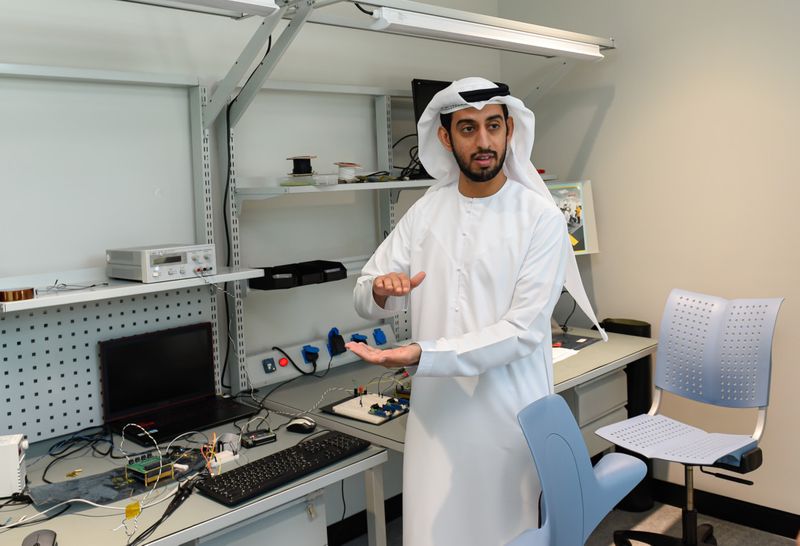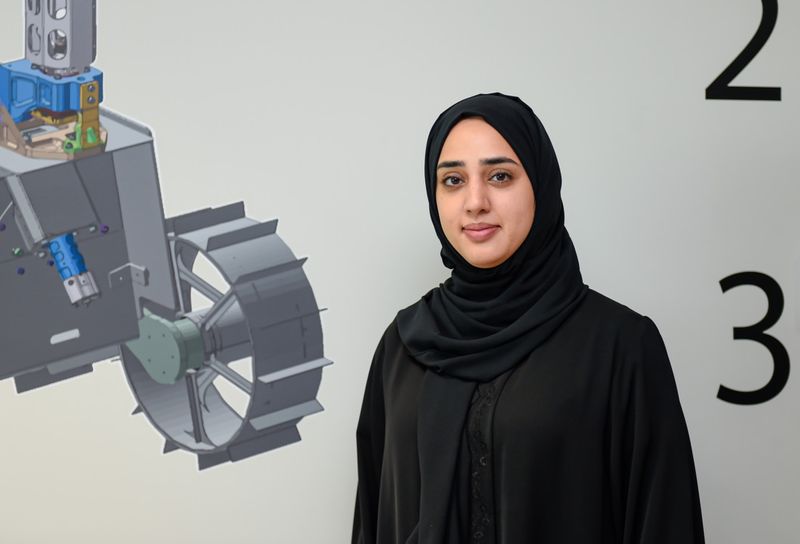Like Our Facebook Page For Latest News
Dubai: Members of the Emirates Lunar Mission (ELM) — or the men and women behind the Rashid rover — are in a race against time. The Arab world’s first mission to the moon was announced in September last year with an initial launch date of 2024, but it was moved two years ahead of schedule.
In an exclusive interview with Gulf News, Dr Hamad Al Marzooqi, ELM project manager at the Mohammed bin Rashid Space Centre (MBRSC), said they are on schedule despite the new date. “The team has been busy and will be busier in the coming months,” noted Al Marzooqi while showing a prototype of ‘Rashid’, an Emirati-made lunar rover named after the late Sheikh Rashid bin Saeed Al Maktoum.
The prototype will be tested between June and July at a facility outside the UAE. It will undergo rigid qualification testing, including a simulated launch on lunar surface environments. Once the testing of the prototype satisfies the team, the development of the Rashid rover will begin. “I can’t remember a time when the team was not busy and I don’t think there will be a time we can relax,” said Al Marzooqi during the interview held at the ELM office in Dubai Silicon Oasis during Ramadan.

Image Credit: Virendra Saklani/Gulf News
Mission ready for 2022
The mission was announced by His Highness Sheikh Mohammed bin Rashid Al Maktoum, Vice-President and Prime Minister of the UAE and Ruler of Dubai, in September last year and the original goal was to land on the moon by 2024.
Al Marzooqi said: “After announcing our collaboration with ispace (the Japanese private lunar robotic exploration company that will transport Rashid to the moon) this month, and moving the launch period two years earlier, there has been a lot of pressure on the team, but I believe the team is highly capable. We have already done a lot of work, but there is still a lot of work to be done and the team is ready for the mission for 2022.”
Made in the UAE
Rashid is the smallest and lightest rover to be deployed on the surface of the moon. To be built at a height of 70cm (2.3ft), its weight is approximately 10kg with payload. Its length is 50cm and width is 50cm. It is being designed and built in the UAE by a team of Emirati engineers, experts and researchers.
A landing site on the moon is expected to be announced soon. Rashid — on board ispace’s robotic lunar lander called Hakuto-R (Hakuto-Reboot) — will land on the near side of the moon, which offers a smoother surface with less craters. If successful, the UAE and Japan will together become the fourth entity to land on the lunar surface, after the United States, former Soviet Union and China.

Image Credit: Virendra Saklani/Gulf News
Mission: Unexplored area on the moon
Al Marzooqi said Rashid has a “unique mission to explore a new area on the moon that has not been explored before. It will generate a huge amount of very useful scientific data to understand the geography and physical properties of the lunar surface”.
The rover will capture multiple images and send those back to the control room in Dubai. The ELM team will also test new technologies in material science, robotics, mobility, navigation and communications, specially designed to survive and function in the harsh lunar environment.
“The moon is an excellent platform to test new technologies and to do useful scientific research. It is our closest neighbour, compared to other celestial bodies, including Mars. To develop a mission to moon is more convenient than developing a mission to Mars and other celestial bodies,” commented Al Marzooqi.
From moon to Mars
Al Marzooqi also noted there is a global effort to explore the moon as a gateway to Mars. “Space technology requires long time to develop. It is easier and more cost effective to test those technologies on the surface of the moon before making sure they are ready to be used for mission to Mars and other planets,” he added.
ELM is part of MBRSC’s Mars 2117 Programme aimed at building the knowledge and scientific capabilities that will enable the UAE to build Mars Science City and explore Mars to address the challenges of food, water and energy security on Earth.
According to MBRSC, Mars Science City will have laboratories that will stimulate the Red Planet’s terrain and harsh environment for food, energy and water, agricultural testing and studies. It will also enable the UAE to develop life support systems that would make it possible to live on other planets.

Image Credit: Virendra Saklani/Gulf News
Adnan Al Rais, Mars 2117 Programme Director, earlier explained: “For a road map to accomplish future human missions, we need to go first to the moon to develop a lunar gateway and develop robotics missions to enhance technologies and create new discoveries that will help us in the future to achieve our ultimate goal, which is basically to send humans to Mars and building a settlement there.”
Human settlement on the moon
Al Marzooqi told Gulf News that efforts are being made by different international space agencies to develop the lunar gateway. “It will be like an international space station orbiting the moon that will be used to ferry scientific experiments and conduct activities to land on the surface of the moon or used to go to other celestial bodies,” he added.
“Alongside the lunar gateway, there are also efforts to build base stations for human settlement on the moon that can be used to support longer human missions. The moon will also be used as a base camp where we fuel and continue the journey to farther celestial bodies in our solar system,” Al Marzooqi continued.
He added the recent discovery of the presence of water on the sunlit surface of the moon has boosted the idea of supporting the presence of humans on the moon to conduct longer researches and answer intriguing questions about resources relevant for deep space exploration.
Emirati on the moon?
When asked if the UAE will send the first Emirati to the moon, Al Marzooqi replied: “This is something I cannot yet say for certain for now. But we do not know, maybe in the future. We take things in stride. When the UAE government announced its ambitious human settlement programme on Mars, we started by developing our own technological capabilities. Building human settlement on an outer planet requires robotic technology. That is what we are doing right now — taking things step by step. We first develop our capabilities before having a manned mission to moon and Mars,” he added.
Personal journey
Al Marzooqi joined MBRSC in 2015 as a senior expert. He previously worked on the KhalifaSat and started a research and development section under the space engineering department, before joining the ELM, where he is the project manager and lead for the computer and imaging systems of the rover.

Image Credit: Virendra Saklani/Gulf News
Al Marzooqi has a bachelor’s degree in Electrical and Electronics Engineering from the University of Sharjah and a master’s degree in Security, Cryptology and Coding of Information System from the Universites De Grenoble (INPG/UJF), Grenoble, France. He received his PhD in Electrical Engineering from Khalifa University, with a thesis focused on secure and efficient hardware implementations of cryptographic algorithms. He won the best m-government award at the Government Summit 2014 and the smart security contest in 2015. Furthermore, he was awarded the Young Emirati Research Prize in 2012 and 2015.
He told Gulf News: “Being part of the ELM team and working on this mission comes with a very big responsibility. I am very proud of the team. We have all the experiences we’ve gained from previous space missions, including the Hope Probe, Khalifasat, DubaiSat. We are confident to reach the moon and I am very honoured to be part of this team.”
Like Our Facebook Page For Latest News